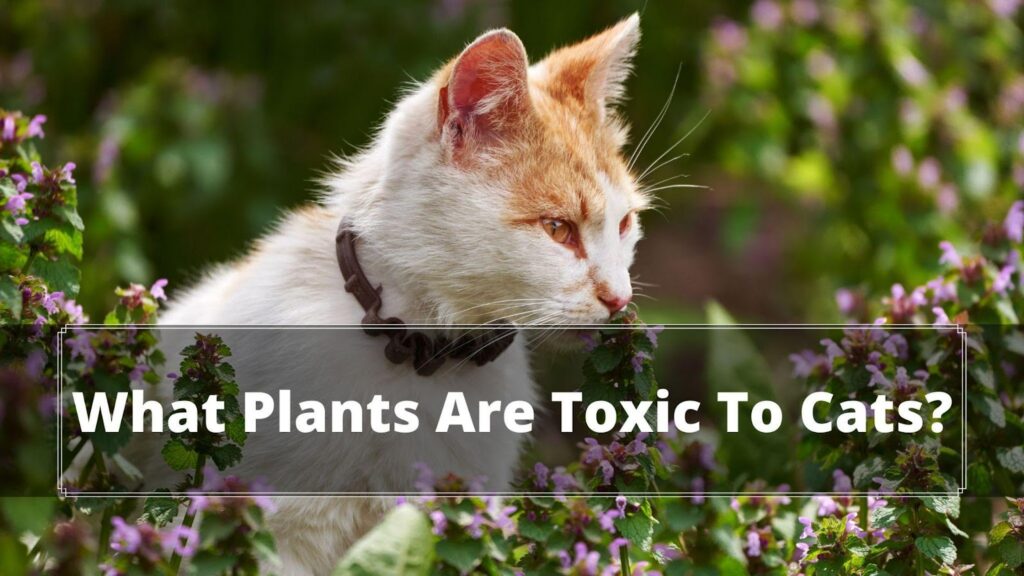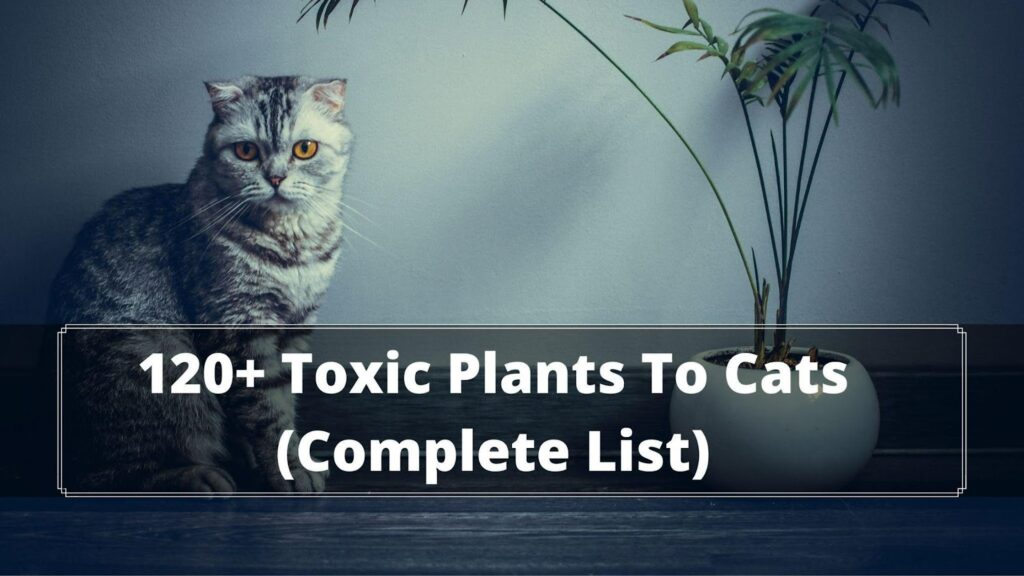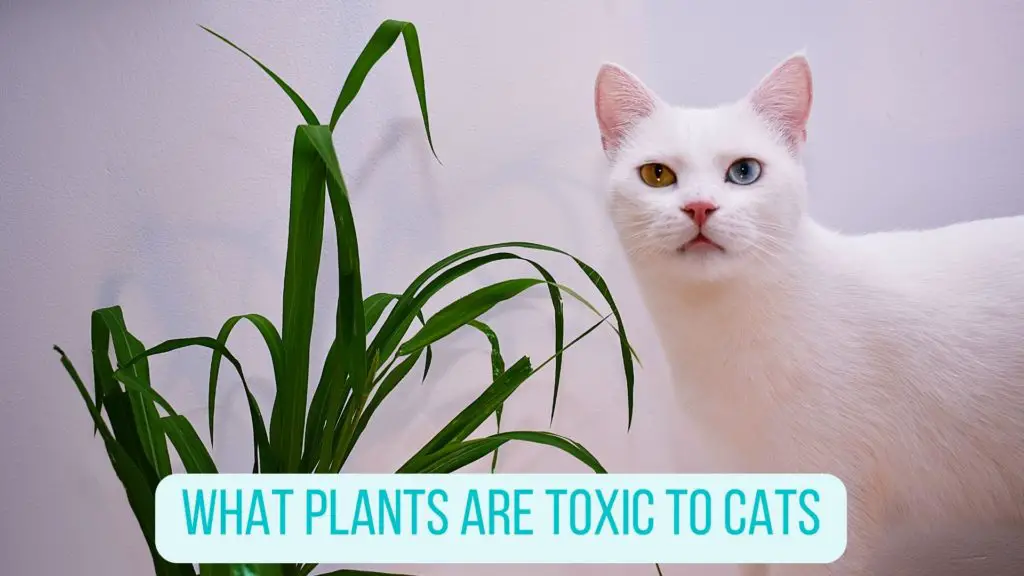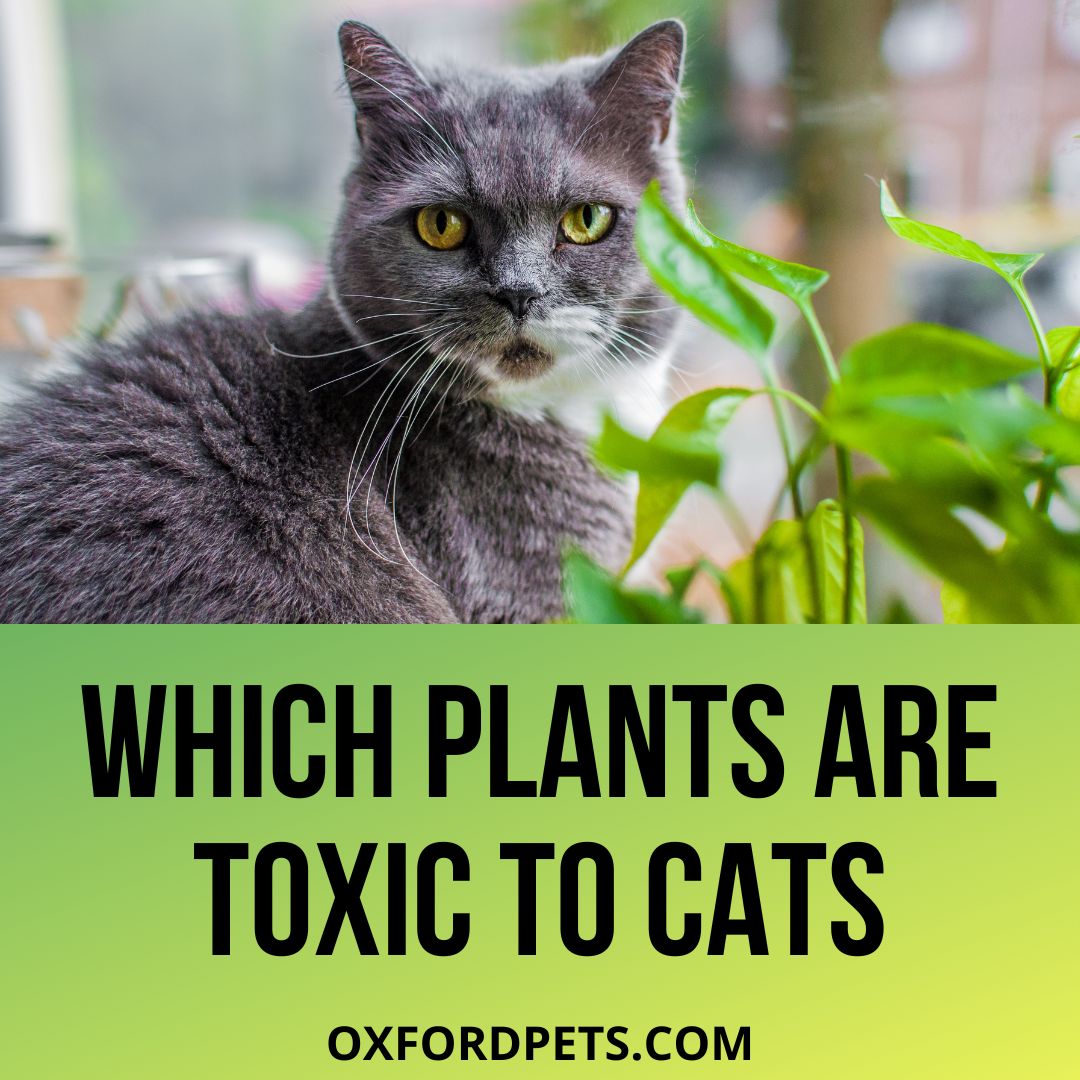If you have a pet-like cat and are also a gardener, maybe you are concerned about planting a plant that can be toxic for them. This article will take a deep look at what plants are toxic to cats.
Always remember that most plants and species release or carry toxins that can harm animals. Being responsible owners, we must be careful about what we use for decorative or hobby purposes around our pets.
Most pets are known for taking a nip of anything that looks consumable (even if it is toxic) out of curiosity. Therefore, knowing what plants are toxic to cats will always keep you ahead of what may come in your cat’s future if any species is grown around her.
Contents
What Plants Are Toxic To Cats?

#1. Peace lily
This plant grows great in low to bright indirect sunlight. They are also excellent as a decoration in any dark room or corner. It makes a perfect indoor plant for offices and apartments also. In shops, they can be used as decorative items. However, there are a few things that you need to consider. One such thing is pets. If you have a pet like a cat, don’t keep this plant nearby.
Keeping this plant nearby will always be a risk of impaction and poisoning to cats. Cats are known to take a nip of everything that looks consumable out of curiosity (leading them to ingest toxins and be poisoned. Peace lilies are a suitable plant for any living space. This plant is effective in cleaning the air of the room as well as lighting it up.
| Scientific name | Spathiphyllum |
| Family | Araceae |
| Subfamily | Monsteroideae |
| Kingdom | Plantae |
| Soil | consistently moist soil |
| Lifespan | 3-5 Years |
| Growing conditions | bright spot out of direct sunlight |
#2. Eucalyptus
Like the peace Lily plant, you should also avoid keeping eucalyptus near any pet, including cats. Even though eucalyptus is used as an ingredient in many products, including medicines, cosmetics, and food, they are not suitable for animals if consumed. The eucalyptus is a fast-going evergreen tree that is native to Australia and has been used as an ingredient to reduce symptoms of colds and cough.
The tree is also used in medicine for signs of congestion. People often plant this tree because it is a fast-growing wood for many uses. The eucalyptus is commonly grown in gardens, parks, Timber, firewood, and pulpwood. But in conclusion, if you have outdoor cats, avoid planting this in your backyard or garden.
| Scientific name | Eucalyptus |
| Family | Myrtaceae |
| Subfamily | Myrtoideae |
| Kingdom | Plantae |
| Soil | well-drained, rich in organic content loamy soils. |
| Lifespan | 50-60 years |
| Growing conditions | soil has good drainage capacity. |
#3. Sago palm
Do you know that this plant is not an individual plant but a common name for groups of plants used to produce “sago,” a starchy food? They are genuine palms in their family with a palm-like appearance.
They are not only adamant about caring but also require particular needs. Even though they are known for surviving in low light conditions, they need bright light to thrive.
They will never tolerate too much moisture. However, for people with pets, sago palms are never recommended to grow around. Whether you have an indoor cat used to walking around your house and backyard or an outdoor cat, make sure to keep her away.
| Scientific name | Cycas revoluta |
| Family | Cycadaceae |
| Order | Cycadales |
| Clade | Tracheophytes |
| Division | Cycadophyta |
| Kingdom | Plantae |
| Growth rate | 1 to 2 inches a year |
#4. Elephant’s ear
The plants with large heart-shaped leaves that grow in tropical regions are usually known as elephant ears. Elephant ears are the common name for a group of tropical perennial plants whose leaves can reach up to 3 ft long and 2 ft wide in right “tropic” conditions. The plant may seem more minor in the winter but will feature impressive leaves.
For cats and dogs, the leaves of these elephant ears are toxic. Therefore, it is recommended never to keep this plant indoors or outdoors, only if you have any pet cat used to roaming around or taking a bite of anything that seems consumable.
| Scientific name | Colocasia |
| Family | Araceae |
| Order | Alismatales |
| Kingdom | Plantae |
| Tribe | Colocasieae |
| Cultivars | COLOCASIA ESCULENTA |
| Sun Exposure | Full sun to part shade |
#5. Garlic
Garlic has many health benefits to humans but not to pets. The bulb-shaped veggie is a very healthy addition to any food and a popular member of the onion family, including scallion, chives, and leaves. Many studies and research have proved that garlic effectively treats inflammation, protects against chronic diseases, and reduces cholesterol levels. But is it consumable for pets like a cat? Garlic is toxic for cats and dogs. Therefore, it is not something that should be around them.
| Scientific name | Allium sativum |
| Family | Amaryllidaceae |
| Subfamily | Allioideae |
| Order | Asparagales |
| Kingdom | Plantae |
| Lifespan | close to six months |
| Growing conditions | light, well-drained soil and likes full sun. |
#6. Onion
Like garlic, onion is also toxic for cats & dogs and should never be served as food. Added to this, an onion plant is not something that should be grown indoors if you have a cat around. It is also unsuitable for growing in the backyard if you have a cat who has a habit of going outdoors or is very outgoing. Onion may be a healthy addition or ingredient to human food but not pet food.
Talking about onions, they are the most widely cultivated species of the genus Allium. Like garlic, onions also feature a bulb-like shape. Onion also effectively treats skin conditions and prevents diseases like cancer and heart problems.
| Scientific name | Allium cepa |
| Family | Amaryllidaceae |
| Subfamily | Allioideae |
| Soil | Onion can be grown in all types of soils such as sandy loam, clay loam, silt loam and heavy soils. |
| Kingdom | Plantae |
| Lifespan | their life cycle is two years long. |
| Growing conditions | Growing onions requires abundant sun and good drainage |
#7. Jade
The Jade plant is trendy for its two different silicate materials: nephrite and Jadeite. This plant is also a good symbol of fortune and has been seen in offices, shops, and lawns as a decorative item. There is no scientific evidence, but many believe that jade carries protective lucky charm energy.
It is also widely used many or for ornaments. But it is not a good option when it comes to growing this plant around pets. If they take a nip, it can be toxic to pets like cats, dogs, and birds.
| Color | Green, Black, White, Red, Yellow, Blue, Purple, Pink, Grey, Brown, Orange |
| Luster | Vitreous, Waxy |
| Crystal system | Monoclinic crystal system |
| Chemical formula | NaAlSi₂O₆ |
| Hardness (Mohs hardness scale) | 6 – 7 |
| Mineral class | Jadeite |
| Transparency | Opaque, Translucent |
#8. Aloe vera (Liliaceae)
People from every corner of the world are aware of this plant because it has many health benefits, which include preventing skin problems repairing damaged cells in the scalp and boosting hair growth.
By applying aloe vera to your hair, you will improve your hair follicles’ health. As it is rich in proteolytic enzymes, it is widely used in cosmetic and medicinal products. Keeping this plant around cats will encourage them to take a few bites out of curiosity. Therefore, you should avoid planting aloe vera around any pet as it can be toxic.
| Scientific name | Aloe |
| Family | Asphodelaceae |
| Subfamily | Asphodeloideae |
| Kingdom | Plantae |
| Soil | A good mix should contain perlite, lava rock, chunks of bark, or all three. |
| Lifespan | 12 years |
| Growing conditions | Aloe vera does best in temperatures between 55 and 80°F (13 and 27°C) |
#9. Hydrangea
Hydrangea is not a plant but a name of the genus of over 75 flowering plant species native to the Americas and Asia. They are famous as a symbol of boastfulness as they feature many gorgeous flowers.
Only a couple of seeds continue to breed, but these are long leaves shrubs that can thrive up to 50 years if cared for properly. They usually enjoy after evening shade and the morning sun. They are not perfect for keeping around cats as they produce toxins that can poison your pet if she consumes enough.
| Order | Cornales |
| Family | Hydrangeaceae |
| Genus | Hydrangea; Gronov. ex L. |
| Kingdom | Plantae |
| Sunlight | Hydrangeas like the morning sun, but do not do well if they’re in the direct, hot afternoon sun. |
| Winter care | Protect hydrangeas during winter with a layer of mulch. |
| Growing conditions | Most hydrangeas will thrive in fertile, well-draining soils that receive plenty of moisture. |
#10. Snake plant
The snake plant is one of the most popular flowering plants native to tropical West Africa from Nigeria east to Congo. The snake plant Is also popularly known as mother in law plant because it is believed to deem a good luck fortune.
However, the most crucial feature of this plant is the ability to absorb poisonous gases from the surrounding air, which removes toxins like benzene and formaldehyde. However, they are not suitable for ingestion. If animals or pets like dogs or cats consume a significant amount of snake plants, it can result in intense toxification and poisoning.
| Scientific name | Dracaena trifasciata |
| Family | Asparagaceae |
| Order | Asparagales |
| Kingdom | Plantae |
| Sunlight | Snake plants prefer bright, indirect light and can even tolerate some direct sunlight. |
| Size | Six inches to 8 feet tall |
| Maintenance | To keep the plant looking its best, water when the soil dries out. |
#11. Wisteria (Fabaceae)
There is no doubt that Wisteria is one of the most popular trees widely grown in backyards. As it features the genus of flowering plants, including ten species of Woody twining vines native to Korea, Japan, Vietnam, China, eastern United States, Southern Canada, and northern Iran, this plant is widely accepted.
In most cultures, the Wisteria plant symbolizes romance. In the south and North Korea, they are particularly popular as a meaning of devotion that transcends. But, when it comes to growing one indoors or outdoors, you should be very cautious.
They are not suitable for animals or pet ingestion. If your cat accidentally ingests the wisteria plant or its part, it can result in several poisoning. Therefore it is never recommended to grow any plant that can produce toxins or harmful elements for pets.
| Scientific name | Wisteria |
| Family | Legumes |
| Subfamily | Faboideae |
| Kingdom | Plant |
| Soil | A deep, moderately fertile, moist soil that does not dry out excessively. |
| Lifespan | wisteria plants can live for more than 50 years |
| Growing conditions | Plant them in fertile, well-drained soil. |
#12. Amaryllis
Amaryllis is a trendy and well-known flowering bulb that comes into species and is a member of a small genus in the subtribe Amaryllidinae. As these plants are susceptible, you must be careful not to injure the leaves or any emerging flower stalks.
You will need to replenish the bulbs to make them bloom again next year. Ensure to keep the soil moist enough by frequent watering and feeding every 7-14 days. Surprisingly, Amaryllises are the only genus in its subtribe.
When it comes to a family with pets, this plant is unsuitable as a decorative item or a hobby. As it produces some toxin that is harmful to pets like cat, it is never recommended to be kept as an indoor or outdoor species anyways.
| Scientific name | Wisteria |
| Family | Amaryllidaceae |
| Subfamily | Amaryllis; L. |
| Order | Asparagales |
| Kingdom | Plantae |
| Tribe | Amaryllideae |
| Growing conditions | Amaryllis can tolerate both sun and shade fairly well but typically fares better somewhere in between – like partial shade. |
#13. Moss rose
If you want to plant succulents in your home, indoor or outdoor, make sure it isn’t around pets. Most types of succulents are not suitable for keeping around pets like cats. On the other hand, if you think of a semi-succulent plant like Moss rose, keep your distance.
Although moss roses are semi succulents that hold water and are suitable for hydration, they produce well-known toxins that harm animals. They’re famous for their fleshy stems and leaves. The bright green colors are very enticing and appealing to people.
Their green leaves come in a cylindrical shape with pointed tips. They are often called portulaca and are grown widely in various parts of the United States. It is also popular as a container plant that you can take up and overwinter indoors.
This plant is suitable for any container gardening enthusiast, requiring nominal care. With appropriate care, portulaca can thrive very well. However, they are not very good for keeping around animals or pets like dogs, birds, or cats.
| Scientific name | Portulaca grandiflora |
| Family | Portulacaceae |
| Order | Caryophyllales |
| Kingdom | Plantae |
| Soil | they thrive in sandy, well-draining soil. |
| Temperature range | between 75 and 85 degrees. |
| Growing conditions | Moss Rose is easy to grow. Grow Moss Rose plants in full sun. Plants prefer average to poor soils. |
#14. Parsley
Do you know that Parsley plants were trendy in the Greek and Roman empires as a garnishing and flavoring ingredient for foods? Besides, their leaves are also widely used in today’s food for their humidly aromatic flavor. It is trendy as an ingredient in foods like fish, sauces, salads, meats, and soups.
In addition, parsley leaves are one of the widely grown plants in European, Eastern, and American cultures. There also commonly used in their cuisine as garnishing. Curly leaf parsley is chopped and served as a top sprinkled on top of many diseases disease.
Therefore, they are also one of the most popular veggie ingredients grown in America. The only thing concerning is the toxins in the leaves for animals and pets. Families with pets are not recommended to increase this green veggie. The leaves of the parsley are toxic for cats and dogs.
| Scientific name | Petroselinum crispum |
| Family | Umbellifers |
| Species | Petroselinum crispum |
| Kingdom | Plant |
| Soil | Parsley grows best in well-drained soil that is rich in organic matter. |
| Water | Parsley will need watering about 2-3 times per week. |
| Growing conditions | a sunny area that receives direct light for six to eight hours a day. |
#15. Chrysanthemum
The Chrysanthemum plant is becoming more and more popular in the United States due to its health benefits. There are many benefits of growing Chrysanthemum. This plant is widely used for medicinal purposes. Chrysanthemum is widely accepted in treating type 2 diabetes, high blood pressure, chest pain, headache, swelling, dizziness, fever, and cold.
However, families with pets should always be cautious when growing plants like this, as it can be toxic for them. The elements or nutrients found in this green are beneficial for humans but not animals. Therefore, avoid keeping this plant nearby cats, dogs, birds, and more.
| Scientific name | Chrysanthemum |
| Order | Asterales |
| Family | Asteraceae |
| Kingdom | Plantae |
| Tribe | Anthemideae |
| Yellowing | Poor Drainage |
27+ Other Toxic Plants To Avoid
| Toxic Plants | Details |
| Mallow | Consumed in large quantities, it can be dangerous. |
| Deadly nightshade | Toxic if eaten, causing nausea or vomiting. |
| Cherry laurel | Consumed in large quantities, and it can be dangerous. |
| German ivy (berries and leaves) | Gastrointestinal tract affected. May cause dermatitis. |
| Milkweed | Consumed in large quantities can be dangerous. It can cause skin irritation.allergy. |
| Laburnum (leaves,seeds) | Toxic if eaten, causing nausea or vomiting. |
| Windflower | Consumed in large quantities, it can be dangerous. |
| Rue | Consumed, can cause nausea and vomiting. This could lead to a skin allergy. |
| Glory lily | Toxic if eaten, causing nausea or vomiting. |
| Clematis | Affected: Gastrointestinal tract, nervous system plant toxins. It May cause dermatitis. |
| Laurel | Consumed in large quantities, it can be dangerous. |
| Poison sumac | Poisonous. Can cause severe blistering dermatitis if they come in contact with the skin. |
| Pokeroot | Toxic if eaten, causing nausea or vomiting. |
| St Johns Wort | Consumed in large quantities, it can be dangerous. |
| Wild cherry tree (twigs and foliage) | Gasping, excitement, prostration. It can be fatal. |
| Calico bush | Consumed in large quantities, it can be dangerous. |
| Poison hemlock | Nervous system affected. It May cause dermatitis and can be fatal. |
| Elderberry | Nausea and vomiting. |
| Flax | Consumed in large quantities, it can be dangerous. |
| Jessamine (berries& sap) | Digestive disturbance. The gastrointestinal tract and nervous system are affected. |
| Rhododendron | Nausea, vomiting, and depression can all be signs of a coma. |
| Iris (roots). | Severe digestive upset. It May cause dermatitis. |
| Easter lily | (Especially toxic to cats). |
| Granny’s bonnets | Consumed in large quantities, it can be dangerous. |
| Foxglove (leaves),seeds) | Toxic if eaten, causing nausea or vomiting. |
| Morning glory (seeds and roots) | Consumed in large quantities, it can be dangerous. |
| German primula | Consumed foods can be toxic. It May cause skin allergy. |
| Swiss cheese plant | If eaten, may cause diarrhea and irritation of the oral cavity. It May cause dermatitis. |
| Buttercup | Juice can cause severe digestive problems. Dermatitis can also be caused by these factors. |
120+ Toxic Plants To Cats (Complete List)

- Lily of the valley bush
- Calla lily (leaves)
- Water hemlock
- Prickly poppy
- Clematis
- Woody nightshade
- Glory lily
- Easter lily
- Hibiscus
- Schefflera
- Narcissus
- Tobira
- Gaultheria
- Angel wings
- Datura
- Yew (berries & foliage)
- Kingcup
- Nerine
- Bluebell
- Angels’ trumpets
- Poison hemlock
- Peruvian lily
- Dragon tree
- Windflower
- Nightshades
- Arborvitae
- Holly (berries)
- Taro vine
- Water Dropwort (Hemlock)
- Jonquil (bulb)
- Marsh marigold
- Chenille Plant
- Juniper
- Rhubarb (leaves)
- Moroccan broom
- Lily
- Hyacinth (bulbs)
- Jack in the pulpit
- Deadly nightshade
- Broom
- Rhododendron
- Iris (roots)
- Corn plant
- Aloe vera
- Savin
- Wild cherry tree (twigs & foliage)
- Sweet pea (stem)
- Hydrangea
- Dumb cane
- Rosebay
- Poison sumac
- Kalanchoe
- Rape
- Larkspur (young plants & seeds)
- Henbane
- Bracken
- Baby’s breath
- Mezereon
- Mountain laurel
- Monkshood
- Squill
- Spurge
- Sago palm
- Poinsettia (leaves, stems & sap)
- Starflower
- German ivy (berries & leaves)
- Tulip
- Granny’s bonnets
- St Johns Wort
- Amaryllis (bulbs)
- Arrow grasses (leaves)
- Apricot (kernels)
- Oak tree (foliage & acorns)
- Lobelia
- Calico bush
- Pokeweed
- Golden chain (seed capsules)
- Japanese yew
- Tobacco plant (leaves)
- Heliotrope
- Echium
- Hurricane plant (bulb)
- Mistletoe (berries)
- Flannel flower
- Apple leaf croton
- Primrose (leaves)
- Azalea (all parts)
- Silkweed
- Laurel
- Peace lily
- Yarrow
- African violet (leaves)
- Boxwood (leaves, twigs)
- European spindle
- Daphne
- Buckeyes (nuts & immature growths)
- Ivy (entire plant)
- Leyland cypress
- Cherry (kernels)
- Rue
- Snowdrops
- Bittersweet
- Raisins
- Rose periwinkle
- Poppy (unripe seedpod)
- Ceriman
- Lenton rose
- Wax tree
- Pineapple broom
- Cineraria
- Geranium
- Apple (seeds)
- Autumn crocus
- Star-of-Bethlehem (bulbs)
- Mallow
- Umbrella plant
- Kale
- Solomon’s seal
- Elephant ears
- Hemlock
- Crowfoot
FAQ
Will Cats Eat Toxic Plants?
It is rare for Cats to take a nip at anything they find. Cats are known for being careful about what they eat. Therefore, indoor cats raised in families may bite the toxic plant out of play or boredom. Kittens are most susceptible to eating harmful poisonous plants.
What Houseplants Are Toxic To Cats?
Following Houseplants should be avoided near cats.
- Jade Plant
- Peace Lily
- Pothos
- English Ivy
- Sago Palm
What Flowers Are Toxic To Cats?
Flowers like hibiscus, Hyacinth, Azalea primroses & mums should never be kept indoors, only if you’ve cats around. These flowers are toxic to most pets, such as dogs, cats & more.
Conclusion
By now, you know what plants are toxic to cats. Therefore, make sure to avoid all plants mentioned above if you’ve any cats around. Feral cats are rarely poisoned by consuming plants or their matter than domestic cats.
If you find the article helpful then be sure to share this. Your one share can motivate us to write more about flowers that are toxic to cats. I hope you like this article and share this. Do check our other helpful guides on cat care too. Have a great, take care, and goodbye.

IN SUMMARY
In conclusion, there is no single answer for what plants are toxic to cats. Every cat owner has to do his or her homework in order to make sure that their cats are not going to be negatively affected by a plant.
Regardless, remember to take precautions around potentially poisonous plants as well
